![]()
![]()
![]()
Use LEFT and RIGHT arrow keys to navigate between flashcards;
Use UP and DOWN arrow keys to flip the card;
H to show hint;
A reads text to speech;
110 Cards in this Set
- Front
- Back
|
Steps in evolution of Eukaryotes?
|
1. Cytoplasm, cell membrane, and nucleus are from Archaea.
2. Development of phagotrophy (particle feeding). 3. Endocytosis of mitochondria 4. For algae and plants: -Endocytosis of cyanobacteria -Possibly further endocytosis of other parts |
|
|
Origin of the nucleus?
|
Nucleus is thought to be developed by infolding of the cell membrane to surround the DNA (also gave rise to endoplasmic reticulum)
|
|
|
Possible by lack of cell wall?
|
Phagotrophy
-Actin-myosin mini-muscles allow pinching off of particle, enclosed within vesicle. |
|
|
Mitochondria and Chloroplasts originated via:
|
Serial Endocytosis
|
|
|
Describe serial endocytosis:
|
Mitochondrion:
-Engulphing but not digesting an aerobic proteobacterium -Endosymbios, allowing efficient cell respiration to be used by host -Loss of cell wall of proteobacterium -Transfer of much of DNA to host nuclear DNA -Mitochondrion retains essential DNA to carry out its functions -Divide by binary fission under control of host’s division cycle |
|
|
Mitochondiral origin (simplified)?
|
-Incorporation of preoteo- or cyanobacterium into host cell
-Loss of bacterial cell wall -Transfer of some genes to nucleus |
|
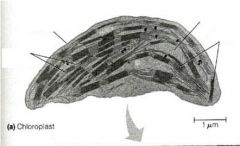
Label
|

|
|
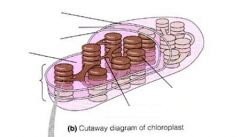
Label
|

|
|
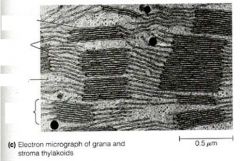
Label
|

|
|
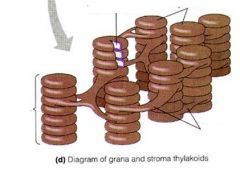
Label
|

|
|
|
In mitochondria, protons flow from _______ to _______.
|
Inner membrane, matrix
|
|
|
In chloroplasts, protons flow from _______ to _______.
|
thylakoid membrane, stroma
|
|
|
Explain mitochondrial membrane
|
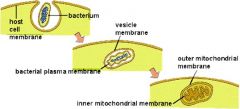
|
|
|
some algae have ________ plastids.
|
secondary (or tertiary)
|
|
|
secondary plastid? (what does picture look like?)
|
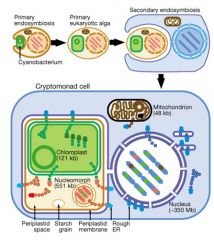
|
|
|
Characteristics of Algae
|
-Any photosynthetic protist
-Aquatic (or terrestrial in moist habitats) -May be unicellular or multicellular -May be in colonies, filaments, or have tissues -Plastids (e.g. chloroplasts) can be primary, secondary, or tertiary -Some algae exhibit harmful "blooms". |
|
|
many origins?
|
Polyphyletic (Protista did not all descend from common ancestor)
|
|
|
algae plastids (chloroplasts) can be...?
|
primary, secondary, or tertiary.
|
|
|
Eukaryotes are a ____phyletic group.
|
monophyletic group
|
|
|
How do we know that all eukaryotes descended from a common ancestor?
|
all contain nucleus + mitochondria
|
|
|
Every eukaryote that is not Animalia, Plantae, or Fungi?
|
Protista
|
|
|
Any photosynthetic member of the protista?
|
Algae
|
|
|
Algae are a _____phyletic group.
|
monophyletic
|
|
|
in bacteria, light reactions take place in the ________.
|
cell membrane
|
|
|
in bacteria, the proton gradient is established between ______ and _______.
|
periplasm and cytoplasm
|
|
|
in bacteria, carbon fixation takes place in _________.
|
cytoplasm
|
|
|
in cyanobacteria, photosynthesis occurs in a specialized internal membrane system called the ______________.
|
thylakoid almellae
|
|
|
in cyanobacteria, light reactions takes place in _________.
|
the membrane
|
|
|
in cyanobacteria, the proton gradient is established between ________ and ________.
|
thylakoid lumen and cytoplasm
|
|
|
in cyanobacteria, carbon fixation takes place in ________.
|
cytoplasm.
|
|
|
in algae, pholosynthesis takes place in ________ (derived from ________)
|
chloroplasts, (cyanobacteria)
|
|
|
in algae, light reactions occur in _________.
|
thylakoid membranes (lamellae)
|
|
|
in algae, proton gradient is established between _______ and ________.
|
thylakoid lumen and stroma
|
|
|
in algae, the calvin cycle takes place in ______. (derived from ________)
|
the stroma (derived from cytoplasm of cyanobacteria)
|
|
|
Why is it a challenge for plants to get CO2?
|
-In order to get CO2, they need to open their stomata.
-But, H2O evaporates out and may cause desiccation -Tradeoff: open stomata to get CO2 or risk desiccation by closing stomata. ---Response close stomata because desiccation=death |
|
|
What is the challenge for plants whenever stomata are closed?
|
-CO2 becomes depleted and O2 builds up.
|
|
|
Why is it a problem when plants withhold too much O2 in their leaves?
|
-When the O2 to CO2 ratio is high, RuBisCO acts as oxygenase (not carboxylase) instead and breaks down RuBP ---“undoes” work of carbon fixation
|
|
|
what is it called whenever O2 concentration "undoes" work of carbon fixation?
Describe.. |
-This is called photorespiration
-Unlike respiration, photorespiration results in no ATP synthesis. -It wastes CHO and ATP that went into making it, -Costs additional ATP to detoxify ammonium |
|
|
Why do plants carry out photorespiration?
|
They can’t help it: RuBisCO evolved in high CO2, low O2 atmosphere
|
|
|
What are the two solutions to the challenges of photosynthesis in plants?
|
CAM (Crassulacean Acid Metabolism)
and C4 Photosynthesis |
|
|
Why is it a challenge for plants to get CO2?
|
-In order to get CO2, they need to open their stomata.
-But, H2O evaporates out and may cause desiccation -Tradeoff: open stomata to get CO2 or risk desiccation by closing stomata. ---Response close stomata because desiccation=death |
|
|
What is CAM?
(Carrulacean Acid Metabolism) (Condense flashcard at a later date) |
-Plant stores up CO2 at night when it is cooler and more humid, separating phototlysis from carbon fixation in time
----Stomata are open at night and closed during the day (low evapotranspiration) ----During night, CO2 is converted to malic acid (a 4-Carbon compound) ----During the day, malic acid is converted back to CO2 Conversions cost additional ATP ----Photolysis and Calvin cycle occur under high CO2 concentration -Calvin cycle can occur when ATP and NADPH are in high supply from light-dependent reactions but CO2 is in high supply from being fixed at night…until the plant runs out of CO2 (capacity to store up CO2 is not unlimited) -Has evolved many times in seedless vascular plants, gymnosperms, and angiosperms convergent evolution ----Used by stonecrops, cacti, orchids, bromeliads, etc. ----Plants of hot, arid environments |
|
|
What is the challenge for plants whenever stomata are closed?
|
-CO2 becomes depleted and O2 builds up.
|
|
|
Describe C4 photosynthesis.
(Condense flashcard at a later date) |
-C4 plants have Kranz anatomy, “wreaths” of bundle sheath cells around vascular bundles
-Isolates RuBisCO from O2 by photolysis and carbon fixation reactions in space ----Light-dependent reactions produce O2, occur in mesophyll cells ----Light-independent reactions require RuBisCO, take place in bundle sheath cells +++++CO2 is converted to a 4-Carbon compound in the mesophyll cells and transported to the bundle sheath cells, where it is converted back to CO2. +++++Bundle sheath cells have a high concentration of CO2 and very little O2 --> very little risk of photorespiration -These extra conversions take additional ATP (compared to C3) but worth the cost when it is hot and arid) ----Stomata can close to save H2O and photosynthesis can continue with saved up CO2 -C4 has evolved many times (but only in angiosperms) convergent evolution ----Especially “warm season grasses” common in prairies. |
|
|
Why is it a problem when plants withhold too much O2 in their leaves?
|
-When the O2 to CO2 ratio is high, RuBisCO acts as oxygenase (not carboxylase) instead and breaks down RuBP ---“undoes” work of carbon fixation
|
|
|
what is it called whenever O2 concentration "undoes" work of carbon fixation?
Describe.. |
-This is called photorespiration
-Unlike respiration, photorespiration results in no ATP synthesis. -It wastes CHO and ATP that went into making it, -Costs additional ATP to detoxify ammonium |
|
|
Why do plants carry out photorespiration?
|
They can’t help it: RuBisCO evolved in high CO2, low O2 atmosphere
|
|
|
What are the two solutions to the challenges of photosynthesis in plants?
|
CAM (Crassulacean Acid Metabolism)
and C4 Photosynthesis |
|
|
What is CAM?
(Carrulacean Acid Metabolism) (Condense flashcard at a later date) |
-Plant stores up CO2 at night when it is cooler and more humid, separating phototlysis from carbon fixation in time
----Stomata are open at night and closed during the day (low evapotranspiration) ----During night, CO2 is converted to malic acid (a 4-Carbon compound) ----During the day, malic acid is converted back to CO2 Conversions cost additional ATP ----Photolysis and Calvin cycle occur under high CO2 concentration -Calvin cycle can occur when ATP and NADPH are in high supply from light-dependent reactions but CO2 is in high supply from being fixed at night…until the plant runs out of CO2 (capacity to store up CO2 is not unlimited) -Has evolved many times in seedless vascular plants, gymnosperms, and angiosperms convergent evolution ----Used by stonecrops, cacti, orchids, bromeliads, etc. ----Plants of hot, arid environments |
|
|
Describe C4 photosynthesis.
(Condense flashcard at a later date) |
-C4 plants have Kranz anatomy, “wreaths” of bundle sheath cells around vascular bundles
-Isolates RuBisCO from O2 by photolysis and carbon fixation reactions in space ----Light-dependent reactions produce O2, occur in mesophyll cells ----Light-independent reactions require RuBisCO, take place in bundle sheath cells +++++CO2 is converted to a 4-Carbon compound in the mesophyll cells and transported to the bundle sheath cells, where it is converted back to CO2. +++++Bundle sheath cells have a high concentration of CO2 and very little O2 --> very little risk of photorespiration -These extra conversions take additional ATP (compared to C3) but worth the cost when it is hot and arid) ----Stomata can close to save H2O and photosynthesis can continue with saved up CO2 -C4 has evolved many times (but only in angiosperms) convergent evolution ----Especially “warm season grasses” common in prairies. |
|
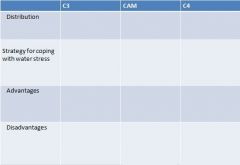
FILL IN
|

|
|
|
Benefits of green roofs?
|
-Storm water retention
-Insulation -Evaporative cooling -Green space |
|
|
Does using plants of different functional types (C3, CAM, C4) help maximize green roof performance?
|
Here's why it would:
In the spring and fall C3 plants grow best. In the summer, C4 plants grow best. ETC. |
|
|
First land plants?
|
Bryophytes
|
|
|
__________ has had a dramatic effect on Earth’s atmosphere and climate, and vice versa
|
Plant macroevolution
|
|
|
What does it mean to say that plant and animals co-evolved?
|
As plants develop more and more for life on land, animals develop new strategies for exploiting plant productivity.
|
|
|
Characteristics of plants?
|
1. Photosynthetic
2. Cellulose-Rich Cell Walls 3. Multi-cellular 4. Terrestrial |
|
|
Adaptations to life on land?
|
Tissues produced in apical meristems.
Embryos. Spores protected by tough cell walls. Alternation of generations. |
|
|
Characteristics of Charophycean green algae?
|
Apical meristems sometimes present but don't produce tissues;
Zygoes are the only diploid cells; Lack sporangia (specialized structures to produce spores); Spores lack sporopollenin walls |
|
|
Characteristics of Embryophytes (all land plants)
|
Apical tissue-producing meristems;
Multi-cellular sporophytes (diploid stage) Sporangia present; Spores have sporopollenin walls to reduce dessication |
|
|
Characteristics of Bryophytes (Liverworts, Hornworts, and Mosses)
|
No lignified vascular tissue;
No true roots, stems, or leaves; Sporophytes unbranched and cannot grow independently of gametophyte. |
|
|
Two generations in alternation of generations?
|
Sporophyte (Produces spores)
Gametophyte (Produces gametes) |
|
|
2n generation
|
Sporophyte generation
|
|
|
1n generation
|
Gametophyte generation
|
|
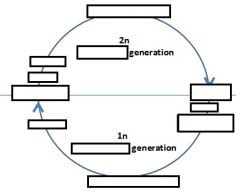
Fill in the Blanks
|

|
|
|
All plants share alternation of generations, but the relative rold of ________ and _______ differs among phyla.
|
gametophyte & sporophyte
|
|
|
"Amphibians" of the plant kingdom?
|
Bryophytes (still tied to water for life history)
|
|
|
What is special about Bryophyte sperm?
|
it is "Swimming" (must have liquid water to reproduce)
|
|
|
What is special about bryophyte roots?
|
They don't have any. They must have a moist surface to diffuse water into rhyzoids.
|
|
|
Do bryophytes have any vascular tissue?
|
No.. Water diffuses cell to cell, which limits height attainable.
|
|
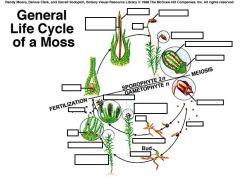
Fill in the Blanks
|

|
|
|
How did plants colonize land?
|
With the help of FUNGI!!!!
|
|
|
How did Fungi help plants colonize land?
|
1. Fungi were parasitic on ancestral green algae
---Similar microbial communities of fungi and algae present on primitive soil surface 2.Infection by fungi may have become beneficial to algae in nutrient-poor terrestrial environment ----Fungi have hyphae that can grow through soil and forage for nutrients ----Nutrients diffuse through fungal hyphae and into algae “accidentally”. ----Plants evolve ability to recognize different types of fungi and allow beneficial ones to infect them, while defending themselves against harmful fungi. 3. Now, > 90% of all plants are capabable of producing mycorrhizal associations. Many must produce these to survive. ----Only some plant species don’t produce mycorrhizal associations, and it is hypothesized that this is a secondary adaptation allowed by evolution of better roots. ----Roots themselves may have evolved to provide better habitat for the fungal partner! |
|
|
Have you visited the links?
|
http://www.us-parks.com/arches-national-park/cryptobiotic-soil.html
http://en.wikipedia.org/wiki/Cryptobiotic_soil http://ctacf.org/index.cfm/2007/3/1/Mycorrhizae-and-the-American-Chestnut-An-Underground-Tale-of-Mystery |
|
|
Explain Lichen Reproduction..
|
asexually by clumps of hyphae surrounding algae breaking off
Sexually—fungus produces spores which must then germinate and acquire new photobionts |
|
|
Lichen Characteristic...
|
Fungus (mycobiont) with an endosymbiotic alga or cyanobacterium (photobiont)
Polyphylletic |
|
|
In ferns and all higher plants, the _____ stage withers away, and the ________ grows into a free-living independent plant
|
gemetophyte, sporophyte
|
|
|
all spores are the same?
|
homosporous
|
|
|
male and female spores are different?
|
heterosporous
|
|
|
Four steps in the Evolution of Roots
|
1.Dimorphic subterranean rhizome systems
2. Some stems become thinner and longer 3. Other rhizomes remain thick 4. Mycorrhiza formation is restricted to the this rhizomes |
|
|
Elaborate:
Step 1. Dimorphic subterranean rhizomes |
Dimorphic subterranean rhizome systems evolve in response to the conflict between optimum designs for nutrient uptake, mycorrhiza formation, mechanical support and survival.
|
|
|
Elaborate:
Step 2: Some steps become thinner and longer |
Some stems become thinner and longer to increase contact with the soil and absorptive capacity. These also grow faster, have a shorter lifespan and evolve a separate phenology.
|
|
|
Elaborate:
Step 3: Other rhizomes remain thick |
Other rhizomes remain thick and evolve more protective features to limit permeability and facilitate long-term survival in soil.
|
|
|
Elaborate:
Step 4: Mycorrhiza formation is restricted to the rhizomes |
Mycorrhiza formation is restricted to the thin rhizomes, which grow when fungi are active and can be renewed as required to provide sufficient habitat for mycorrhizas to meet plant nutrient requirements.
|
|
|
Single vein per leaf?
|
Microphylls (on lycophytes)
-Derived from sporangia (or from spiny enations [outgrowths]) |
|
|
Many branched veins per leaf?
|
Megaphylls (aka euphylls on pteridophytes and seed plants)
-50 million years later, derived from fusion of branches (read Beerling 2005 intro) |
|
|
Describe evolution of microphylls
|
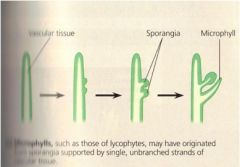
|
|
|
Describe evolution of megaphylls
|

|
|
|
How do roots affect weathering?
|
Read article
|
|
|
How does weathering affect CO2 level?
|
weathering releases Ca and Mg that was locked up in the silicates of rocks, this Ca (Mg) flows to the ocean where they are combined with HCO3 to form calcium carbonate that shell animals use for the building of their shells. thus REDUCING the atmospheric CO2 levels.
|
|
|
The first land plants?
|
Lycophytes
|
|
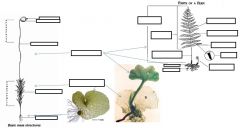
Label
|

|
|
|
Describe the role of a fern gametophyte relative to the sporocyte.
|
This is a fern gametophyte. Notice how small this plant is - barely half a centimeter long. This is the most vulnerable stage in the life cycle of the fern - the gametophytes are prone to dessication, trampling, being eaten, and being out shaded by the surrounding foliage. Additionally, when the young sporophyte emerges, it is essentially a parasite on the gametophyte until it can grow its first leaf. The gametophyte must nurture the young sporophyte until it grows large enough to produce its own food.
|
|
|
The club moss life cycle is: _____
(Which means?) |
homosporous
(All spores are the same) Refer to diagram.* |
|
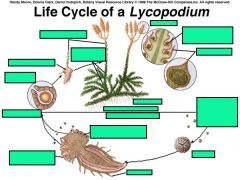
Label
|

|
|
|
Fern life cycle is ______
(Meaning what?) |
Homosporous
All spores are the same Refer to diagram.* |
|
|
Describe the life cycle of a fern
|
1. An embryo develops from the zygote and is nurtured initially by the gametophyte.
2. The young sporophyte develops to become self-sufficient and the gametophyte degenerates. 3. The mature sporophyte consists of leafy fronds. This is the plant one usually recognizes as a fern. 4. Sori develop on the ventral portion of pinnae (leaflets) of the mature fern sporophyte, and within these sporangia form 5. Sporogenous tissue within the sporangia undergoes meiosis. 6. Spores disperse. 7. Photosynthetic haploid gametophytes develop from the germinating spore. 8. The gametophyte is generally amorphous to heart-shaped with root-like rhizoids projecting downward to anchor the plant. Also located ventrally are male antheridia within which sperm develop and mature, and female archegonia within which eggs develop and mature. 9-10.Rain induces swelling in the antheridia, causing them to burst and release multiflagellated sperm that are transported via water droplets to the egg. 11. Fertilization results in a diploid zygote. |
|

Label
|
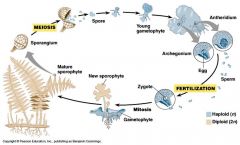
|
|
|
Club moss life cycle is ______.
(Meaning what?) |
heterosporous
(male and female spores are different) Refer to diagram.* |
|

Label
|
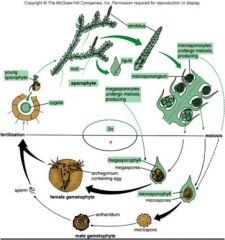
|
|

Fill In
|

|
|
|
Non-vascular plants (______) lack _____, ______, and _______, which all rely on _________.
|
(bryophytes)
stems, leaves, and roots. vascular tissue |
|
|
Some _________ have interconnected chains of cells that act like a primitive _______.
|
bryophytes
vascular system |
|
|
Lack of vascular system prevents what?
|
Lack of vascular system prevents non-vascular plants from growing tall or away from liquid water (or they go dormant when dry).
|
|
|
How did the vascular system come about?
|
-Possible chain of events:
**Enlarge plasmodesmata to form channels -----Plasmosdemata: Openings through cell walls; cytoplasm is symplastic -----Allows movement of fluids, nutrients, proteins, etc. **Controlled death (loss of nucleus, organelles, and cytoplasm) to allow free flow of fluids -----Some bryophytes have gone up to this point **Formation of secondary cell walls to reinforce the channel **Water-proofing and decay resistance by lignin |
|
|
Vascular tissue allows for specialization of what plant organs? (and specialty for each?)
|
**Stems for transport and support
**Leaves for photosynthesis **Roots for nutrient and water uptake and support |
|
|
Describe the evolution of seeds.
|
1. Dimorphic subterranean rhizome systems evolve in response to the conflict between optimum designs for nutrient uptake, mycorrhiza formation, mechanical support and survival.
2. Some stems become thinner and longer to increase contact with the soil and absorptive capacity. These also grow faster, have a shorter lifespan and evolve a separate phenology. 3. Other rhizomes remain thick and evolve more protective features to limit permeability and facilitate long-term survival in soil. 4. Mycorrhiza formation is restricted to the thin rhizomes, which grow when fungi are active and can be renewed as required to provide sufficient habitat for mycorrhizas to meet plant nutrient requirements. |
|
|
What are the two independent origins in the evolution of leaves?
|
Microphylls and Megaphylls (Also known as Euphylls)
|
|
|
Describe the two evolutionary forms of leaves.
|
Microphylls (on lycophytes)
Single vein per leaf Derived from sporangia (or from spiny enations [outgrowths]) Megaphylls (aka euphylls, on Pteridophytes and seed plants) Many, branched veins per leaf 50 million years later, derived from fusion of branches |
|

Label
|
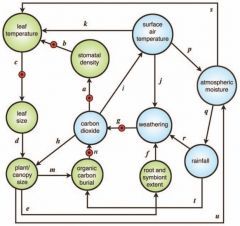
|

